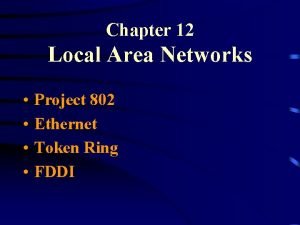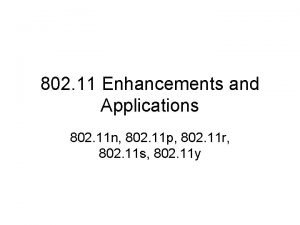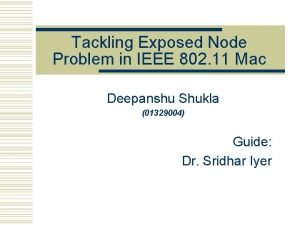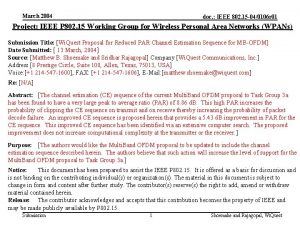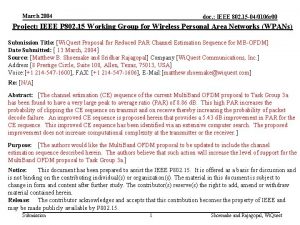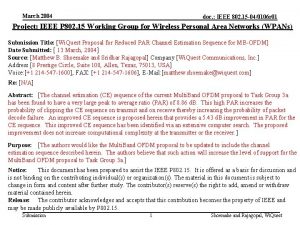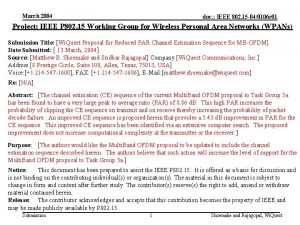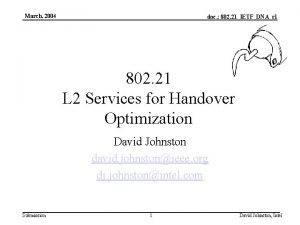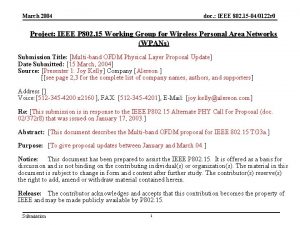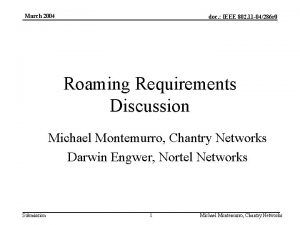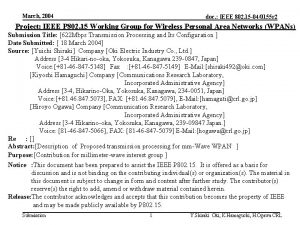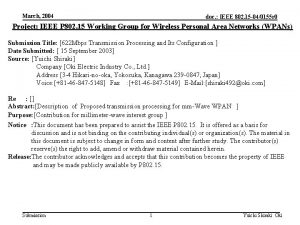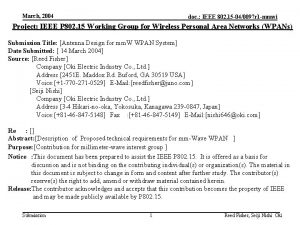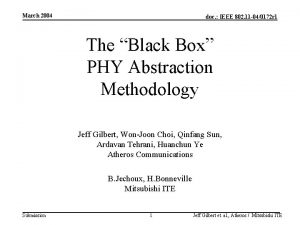March 2004 doc IEEE 802 15 040106 r















- Slides: 15

March 2004 doc. : IEEE 802. 15 -04/0106 r 00 Project: IEEE P 802. 15 Working Group for Wireless Personal Area Networks (WPANs) Submission Title: [Wi. Quest Proposal for Reduced PAR Channel Estimation Sequence for MB-OFDM] Date Submitted: [ 13 March, 2004] Source: [Matthew B. Shoemake and Sridhar Rajagopal] Company [Wi. Quest Communications, Inc. ] Address [8 Prestige Circle, Suite 100, Allen, Texas, 75013, USA] Voice: [+1 214 -547 -1600], FAX: [+1 214 -547 -1606], E-Mail: [matthew. shoemake@wiquest. com] Re: [N/A] Abstract: [The channel estimation (CE) sequence of the current Multi. Band OFDM proposal to Task Group 3 a has been found to have a very large peak to average ratio (PAR) of 8. 86 d. B. This high PAR increases the probability of clipping the CE sequence on transmit and on receive thereby increasing the probability of packet decode failure. An improved CE sequence is proposed herein that provides a 5. 43 d. B improvement in PAR for the CE sequence. This improved CE sequence has been identified via an extensive computer search. The proposed improvement does not increase computational complexity at the transmitter or the receiver. ] Purpose: [The authors would like the Multi. Band OFDM proposal to be updated to include the channel estimation sequence described herein. The authors believe that such action will increase the level of support for the Multi. Band OFDM proposal to Task Group 3 a. ] Notice: This document has been prepared to assist the IEEE P 802. 15. It is offered as a basis for discussion and is not binding on the contributing individual(s) or organization(s). The material in this document is subject to change in form and content after further study. The contributor(s) reserve(s) the right to add, amend or withdraw material contained herein. Release: The contributor acknowledges and accepts that this contribution becomes the property of IEEE and may be made publicly available by P 802. 15. Submission 1 Shoemake and Rajagopal, Wi. Quest

March 2004 doc. : IEEE 802. 15 -04/0106 r 00 Outline • Overview of current packet preamble • Desired properties in packet preamble • Peak to Average Ratios for MB-OFDM and IEEE 802. 11 a/g • The problem of high PAR • Improved Channel Estimation Sequence with PAR reduction of 5. 34 d. B • Conclusions and Proposal Submission 2 Shoemake and Rajagopal, Wi. Quest

March 2004 doc. : IEEE 802. 15 -04/0106 r 00 Current PLCP Preamble (268 r 3) • Symbols of Packet Sync Sequence – Packet Detection – AGC – Frequency Estimation • 3 Symbols of Frame Sync Sequence – Boundary Detection/FFT Placement • 6 Symbols of Channel Estimation Sequence – Channel Estimation – Frequency Estimation Submission 3 Shoemake and Rajagopal, Wi. Quest

March 2004 doc. : IEEE 802. 15 -04/0106 r 00 Desired Properties of Preambles • Packet Detection – Good Correlation Properties – Low Cross-Correlation (SOP) • Frequency Estimation – Multiple repeats • Frame Sync – Low correlation with packet sync • Channel Estimation/AGC – Low PAR – Should have significantly lower clip probability than payload Submission 4 Shoemake and Rajagopal, Wi. Quest

March 2004 doc. : IEEE 802. 15 -04/0106 r 00 Peak to Average Ratio • PAR Calculation – Possible for a given set of tones – Difficult in general • PAR is usually calculated numerically • PAR is dependent on the sampling phase Must oversample the signal to cover different phases and find the true PAR Submission 5 Shoemake and Rajagopal, Wi. Quest

March 2004 doc. : IEEE 802. 15 -04/0106 r 00 Legacy Channel Estimation Sequence (1 of 2) • Legacy sequence PAR: - 7. 09 d. B at Ny. Quist - 8. 86 d. B oversampled • Oversampling approaches: - Use larger FFT - Interpolate in the time domain • Results here use larger FFT • Average energy: 122 Can see visually that signal must be oversampled to obtain accurate PAR Submission 6 Shoemake and Rajagopal, Wi. Quest

March 2004 doc. : IEEE 802. 15 -04/0106 r 00 Legacy Channel Estimation Sequence (2 of 2) • The current sequence has a spike at the end of the sequence • The spike at the end of the sequence causes variation in PAR measurements under various interpolation methods • The spike generates a transient that is a function of design decisions and may affect performance • The spike at the end of the sequence should and can be avoided MBOA PAR SRRC 7. 31 d. B SRRC (repeat) 8. 35 d. B SRRC (zero pad) 7. 36 d. B IFFT (4 x upsample) 8. 85 d. B Sinc (zero pad) 7. 29 d. B Submission There is 1. 49 d. B difference in spike between two reasonable but different implementations. 7 Shoemake and Rajagopal, Wi. Quest

March 2004 doc. : IEEE 802. 15 -04/0106 r 00 PAR Properties for MB-OFDM and 802. 11 a/g Oversample Factor CE r 2 CE r 3 LS 11 a 1 2 4 1024 5. 44 8. 01 7. 09 8. 85 8. 86 3. 17 3. 18 MB-OFDM CE r 2: Channel Estimation Seq in rev 2 (112 tones) MB-OFDM CE r 3: Channel Estimation Seq in rev 3 (122 tones) LS 802. 11 a/g: Long (CE) Sequence of 802. 11 a/g (48 tones) Current CE PAR is too high thereby reducing probability of good channel estimate and increasing packet error probability Submission 8 Shoemake and Rajagopal, Wi. Quest

March 2004 doc. : IEEE 802. 15 -04/0106 r 00 PAR and Conjugation (1 of 2) • Plot shows that the constraint of conjugate symmetry tends to increase the PAR on average by 1. 7 - 2. 0 d. B • Result of unnecessarily forcing the time domain signal to be real valued 1. 7 – 2. 0 d. B Submission 9 Shoemake and Rajagopal, Wi. Quest

March 2004 doc. : IEEE 802. 15 -04/0106 r 00 PAR and Conjugation (2 of 2) In addition to increasing the PAR – Conjugation does not help channel estimation – Conjugation does not reduce complexity or cost • Mandatory rates of 110 and 200 Mbps do not use conjugation Conjugation should be removed from the MB-OFDM channel estimation sequence Submission 10 Shoemake and Rajagopal, Wi. Quest

March 2004 doc. : IEEE 802. 15 -04/0106 r 00 Improved Channel Estimation Sequence Tones(-61: -1 1: 61) = {-1 -1 -1 1 1 -1 -1 -1 1 1 1 -1 1 -1 -1 1 1 -1 -1 -1 1 1 1 1 -1 1 -1 -1 -1 1 1 -1 -1 1 -1 -1 1 } sequence without conjugate symmetry has New PAR of 3. 437 d. B measured with oversampling Submission 11 Shoemake and Rajagopal, Wi. Quest

March 2004 doc. : IEEE 802. 15 -04/0106 r 00 Reduced PAR Sequences 5. 42 d. B Oversample Factor CE r 3 Wi. Quest Non-Conjugate Symmetric Improvement 1024 8. 86 d. B 3. 44 d. B 5. 42 d. B Submission 12 Shoemake and Rajagopal, Wi. Quest

March 2004 doc. : IEEE 802. 15 -04/0106 r 00 Receive PAR • The PAR at the receiver depends on the multipath channel • To confirm that a PAR reduction is maintained at the receiver, cumulative distribution functions were generated for the PAR at the receiver ~3 d. B ~ 1 d. B ~ 0. 7 d. B • The reduced PAR CE sequence was compared to the CE sequence in the current draft in AWGN, CM 1 and CM 2 • A PAR reduction of 0. 7 to 3. 0 d. B exists at the receiver Submission 13 Shoemake and Rajagopal, Wi. Quest

March 2004 doc. : IEEE 802. 15 -04/0106 r 00 Reuse of the Constellation Mapper • Rotation of the CE sequence does not change the PAR • The proposed non-conjugate symmetric sequence is specified over {+1, -1} • Rotating the proposed non-conjugate symmetric sequence by 45 degrees would cause the sequence to be over {+1+j, -1 -j}/sqrt(2) • If the sequence is rotated by 45 degrees, the current QPSK mapper can be used without modification • The authors are open to either approach Submission 14 Shoemake and Rajagopal, Wi. Quest

March 2004 doc. : IEEE 802. 15 -04/0106 r 00 Conclusions and Proposal • Current MB-OFDM channel estimation (CE) sequence has: – A very high PAR of 7. 36 to 8. 86 d. B – An undesirable spike near the end of the sequence – A higher probability of clipping on TX and RX • Sequences exist that provide dramatic reductions in the PAR – A 5. 42 d. B decrease – Provides reduced DAC and ADC resolution The authors propose to replace the channel estimation sequence in the current MB-OFDM proposal with the non-conjugate symmetric sequence on slide 11 Submission 15 Shoemake and Rajagopal, Wi. Quest












